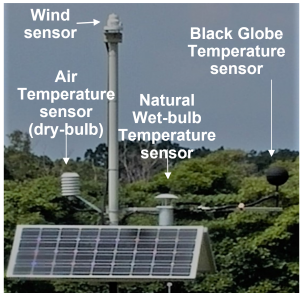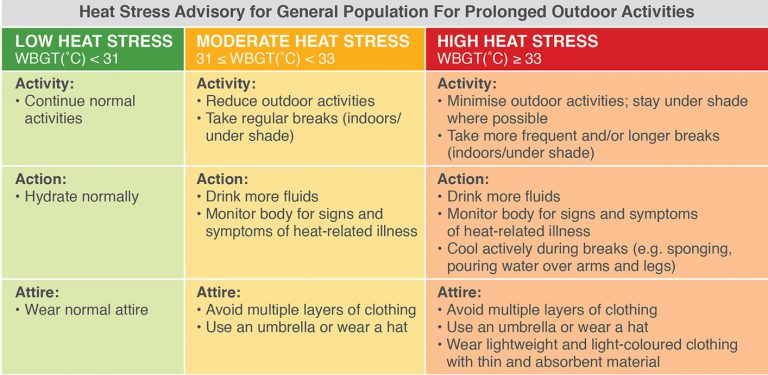- Home
- Learn
- Learn about Heat Stress - Weather Information Portal
Learn about Heat Stress - Weather Information Portal
Singapore is located in the tropics and experiences hot and humid weather conditions all year round. The high relative humidity can inhibit evaporative heat loss and cause metabolic heat to accumulate in the body, resulting in heat stress which can cause heat-related illnesses. Information on heat stress enables us to take appropriate measures to mitigate risks of heat stress and heat-related illnesses, such as heat cramps, heat exhaustion and heat stroke.
One internationally recognised indicator of heat stress is the Wet Bulb Globe Temperature (WBGT). MSS reports the WBGT based on sensors which measure the natural wet-bulb (Tnwb), black globe (Tg) and the dry bulb (Td) temperatures. The natural wet-bulb and black-globe temperatures represent the integrated effects of humidity, solar radiation and wind under direct sunlight.

A WBGT sensor for the assessment of heat stress.
The WBGT is calculated as the weighted sum of three temperature components:
WBGT = 0.7 Tnwb + 0.2 Tg + 0.1 Td
Tnwb is the Natural Wet Bulb temperature, which is measured by a thermometer covered by a cotton wick that is exposed to the natural prevailing air movement as well as radiation. It represents the integrated effect of air temperature, humidity, and wind speed. Tnwb is always lower than the dry bulb temperature. The closer together the values are, the more humid it is. At 100% relative humidity, the Tnwb is equal to the dry bulb temperature.
Tg is the Black Globe temperature, which is measured by a dry bulb thermometer inserted into a standard black metal globe and it represents the integrated effect of air temperature, wind speed and radiant heat.
Td is the dry bulb/air temperature, and represents the temperature of the ambient air measured in the shade. (This is the air temperature values people are familiar with, and is indicated in weather forecasts and reports).
MSS reports the WBGT as a 15-minute average value, updated every 15-minutes. This is to avoid transient fluctuations inherent in instantaneous measurements.
WBGT can reduce significantly in shaded regions with no direct exposure to the sun, and increase significantly under very humid conditions. Therefore, WBGT and air temperature, despite both being temperature measurements (°C), are not interconvertible and are fundamentally different measures. The example below illustrates how WBGT values vary with humidity and globe temperature (solar radiation, cloud cover), while having the same air temperature.
|
WBGT (°C) |
Natural Wet Bulb Temperature (Humidity) |
Black Globe Temperature |
Air Temperature |
|
30.6 |
26.9 °C (63.6%) |
42.8 °C (cloudy midday) |
32 °C |
|
32.3 |
27.5 °C (69.96%) |
48.7°C (possible under hot midday sun) |
32 °C |
Higher WBGT value as a result of higher humidity and globe temperature, while having the same ambient air temperature.
Higher values of WBGT indicate a higher level of heat stress and thus a greater risk of developing heat-related illnesses during prolonged outdoor activities. In Singapore, ‘Moderate’ to ‘High’ heat stress levels usually occur in the late morning and afternoon. ‘High’ heat stress level also occurs more often during the hotter months of April and May.
The WBGT only accounts for the environmental factors (wind, air temperature, air humidity and radiation from the sun and nearby hot surfaces) contributing to heat stress. Individual reactions to heat will vary, and personal factors (e.g.,clothing, individual health status, acclimatization etc.) as well as level of activities are not considered in the WBGT measurement.
[Note: In order to provide comprehensive information to the public, the Heat Stress Advisory pages on myENV app and the weather information website display both the WBGT as well as air temperature readings. However, as most of the WBGT sensors are installed in built-up locations with high human traffic (such as sports stadiums), the air temperature readings could be influenced by additional heat sources. As the air temperatures recorded at these stations represent very localised conditions, they are not used for reporting of historical extremes.]
When our body gets too hot, we begin to perspire or sweat to cool itself off. Evaporation of sweat from the skin surface results in heat loss from the body. However, a high relative humidity (i.e., atmospheric moisture content) decreases the rate of evaporation of sweat, limiting heat removal from the body and therefore a person will feel warmer. On the other hand, a lower humidity level increases the rate of evaporation and facilitates heat removal via evaporation, resulting in the person feeling cooler.
Heat strain occurs when the body is unable to remove excess heat, leading to an increase in the body’s core temperature which can result in heat-related illness.
There are varying severities of heat-related conditions and it can lead to heat stroke.
Signs and symptoms of heat-related conditions include weakness, dizziness, visual disturbances, intense thirst, nausea, headache, vomiting, diarrhoea, muscle cramps, breathlessness, palpitations, tingling and numbness of the hands and feet. Recovery occurs after resting in cool area and consuming cool drinks (e.g. water, clear juice, or a sports drink). These symptoms may, if not identified and the individual not treated appropriately, progress to heat stroke.
Heat stroke is the most serious type of heat-related illness. Signs of heat stroke include a core body temperature that is often, but not always, greater than 40°C, with complete or partial loss of consciousness, disorientation, and seizures. There are two types of heat stroke. Classic/Passive Heat Stroke occurs due to exposure to high heat and humidity and usually occurs in vulnerable groups such as infants and the elderly. Exertional Heat Stroke is caused by prolonged strenuous physical activity, often seen in relatively fit individuals who presented unwell.
Heat-related illness can occur during warm and humid nights. High relative humidity (> 85%) in the night reduces the rate of evaporation from the body, and causes heat to accumulate in the body, which can result in heat-related illnesses during physical exertion. Therefore, caution is advised for high intensity exercise even at night in tropical climates such as Singapore.
The Heat Stress Advisory serves as a guide on the risk of heat-related illnesses during prolonged outdoor activities. The public can use it as a general guide to adjust prolonged outdoor sports or other physical activities, such as hiking and jogging. It does not apply to transient outdoor movement where the exposure to heat is short, and the activity level is not elevated.
In planning for prolonged outdoor activities, we should also consider other factors such as health status, age, duration and intensity of physical activity, type of clothing worn, in addition to environmental factors. Groups more vulnerable to heat stress, including the elderly, children and infants, people who are ill or recently recovered, or have chronic conditions, pregnant women, and recent travelers from cooler climates should exercise greater caution.
Groups such as athletes (SportSG) and outdoor workers (MOM) should refer to their respective sectoral guidelines that are tailored to their requirements. Students should follow the guidance of their schools. These guidelines do not apply to the SAF and the Home Team, as they adopt a comprehensive set of heat injury prevention measures that factor in the heat acclimatisation level of servicemen, intensity of training activity, and on-site medical support during the conduct of training.
The Heat Stress Advisory was developed in consultation with the Ministry of Health’s Heat Stress Guidelines Expert Panel which comprised members from academic and clinical institutions with expertise in fields such as occupational health, emergency medicine, public health, and physiology. In the development of the advisory, the Panel reviewed existing literature, international and local guidelines, and best practices on managing heat stress.


